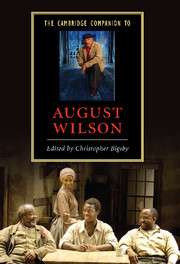Book contents
- Frontmatter
- 1 August Wilson: the ground on which he stood
- 2 Been here and gone
- 3 August Wilson’s relationship to black theatre: community, aesthetics, history and race
- 4 Music and mythology in August Wilson’s plays
- 5 Gem of the Ocean and the redemptive power of history
- 6 Joe Turner’s Come and Gone
- 7 Ma Rainey’s Black Bottom: cutting the historical record, dramatizing a blues CD
- 8 A piano and its history: family and transcending family
- 9 The tragedy of Seven Guitars
- 10 Safe at home?: August Wilson’s Fences
- 11 Two Trains Running: blood on the tracks
- 12 Jitney, folklore and responsibility
- 13 King Hedley II: in the midst of all this death
- 14 Radio Golf: the courage of his convictions - survival, success and spirituality
- 15 Critics on August Wilson
- 16 An interview with August Wilson
- Index
6 - Joe Turner’s Come and Gone
Published online by Cambridge University Press: 28 January 2008
- Frontmatter
- 1 August Wilson: the ground on which he stood
- 2 Been here and gone
- 3 August Wilson’s relationship to black theatre: community, aesthetics, history and race
- 4 Music and mythology in August Wilson’s plays
- 5 Gem of the Ocean and the redemptive power of history
- 6 Joe Turner’s Come and Gone
- 7 Ma Rainey’s Black Bottom: cutting the historical record, dramatizing a blues CD
- 8 A piano and its history: family and transcending family
- 9 The tragedy of Seven Guitars
- 10 Safe at home?: August Wilson’s Fences
- 11 Two Trains Running: blood on the tracks
- 12 Jitney, folklore and responsibility
- 13 King Hedley II: in the midst of all this death
- 14 Radio Golf: the courage of his convictions - survival, success and spirituality
- 15 Critics on August Wilson
- 16 An interview with August Wilson
- Index
Summary
August Wilson created a structural challenge for himself in writing Joe Turner's Come and Gone (1986), the story of some 'footloose wanderers', as the poet and playwright Amiri Baraka called the displaced ex-slaves who, during the early twentieth century, tried to make sense of their social and cultural problems. Critics almost uniformly praised the play but condemned its structure as 'sprawling', 'off the track', and 'confusing'. One was more graphic: 'Wilson's elemental power continues to overwhelm the basic structure of his dramas. His efforts remind you of a large man trying to squeeze into a suit two sizes too small. Every now and then, you hear the fabric ripping.' Implicit in these judgements was the idea that Wilson had wished to link episodes causally through characters, mood association or collage. A close study of the play, however, reveals that Wilson used signature elements from almost every major movement in African American theatre history, intent 'to engage in refiguration as an act of homage', to borrow a Henry Louis Gates, Jr. phrase. They came from German Expressionism, first introduced by Langston Hughes's Don't You Want to Be Free? (1938) and from the choreopoem, pioneered by Ntozake Shange's for colored girls who have considered suicide/when the rainbow would be enuf (1976); from the kitchen table, in William Wells Brown's Escape; Or A Leap for Freedom (1858), to talking winds in Loften Mitchell's A Land Beyond the River (1957); and from the Non-Objectivism of black theatre in the 1960s and 1970s8 to Keith Antar Mason's performance text From Hip-Hop to Hittite and Other Poetic Healing Rituals for Young Black Men(1985).
- Type
- Chapter
- Information
- The Cambridge Companion to August Wilson , pp. 89 - 101Publisher: Cambridge University PressPrint publication year: 2007

